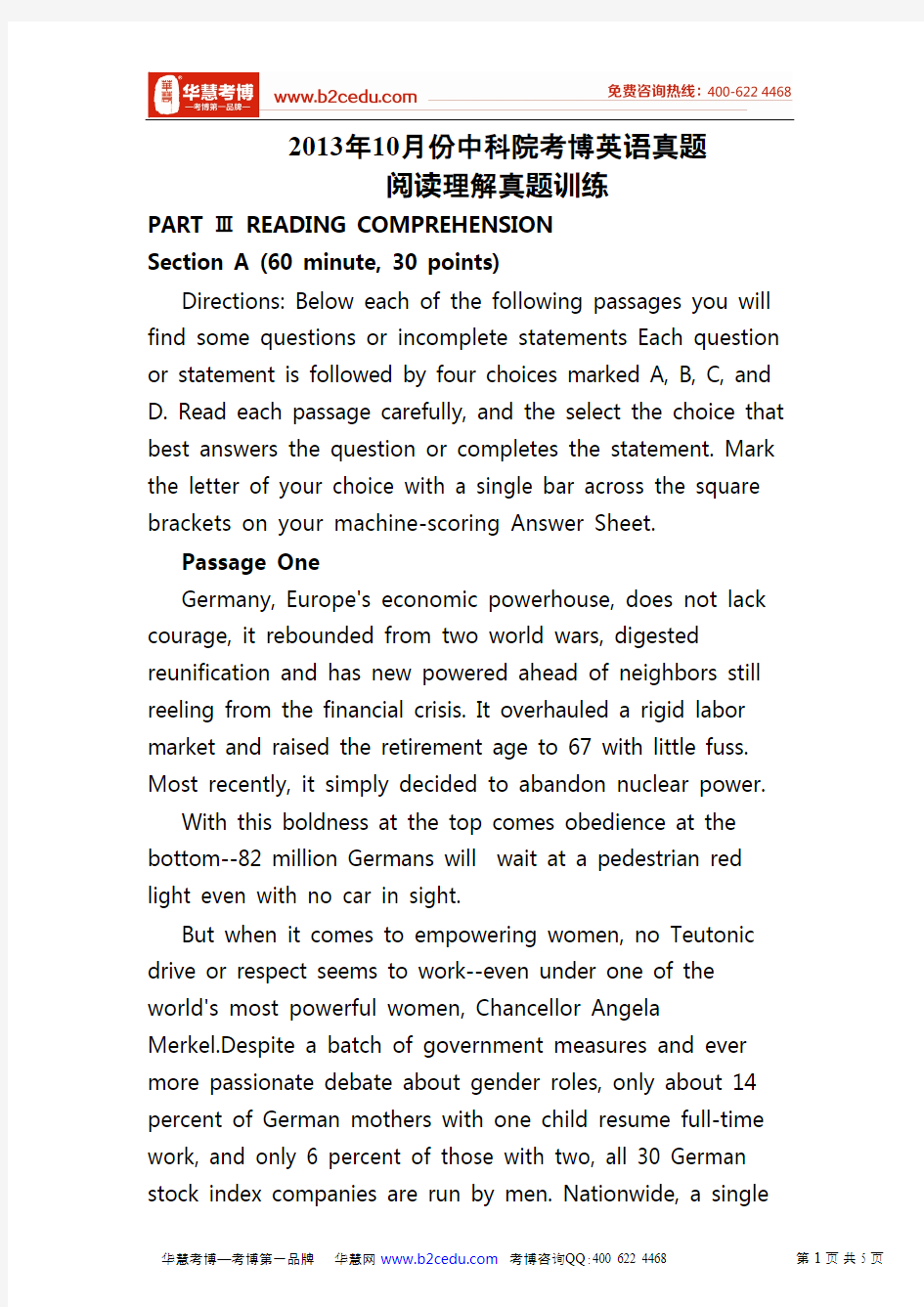华慧2013年10月中科院考博英语真题阅读理解真题训练Section A(第一篇)

- 1、下载文档前请自行甄别文档内容的完整性,平台不提供额外的编辑、内容补充、找答案等附加服务。
- 2、"仅部分预览"的文档,不可在线预览部分如存在完整性等问题,可反馈申请退款(可完整预览的文档不适用该条件!)。
- 3、如文档侵犯您的权益,请联系客服反馈,我们会尽快为您处理(人工客服工作时间:9:00-18:30)。
2013年10月份中科院考博英语真题
阅读理解真题训练
PART Ⅲ READING COMPREHENSION
Section A (60 minute, 30 points)
Directions: Below each of the following passages you will find some questions or incomplete statements Each question or statement is followed by four choices marked A, B, C, and D. Read each passage carefully, and the select the choice that best answers the question or completes the statement. Mark the letter of your choice with a single bar across the square brackets on your machine-scoring Answer Sheet.
Passage One
Germany, Europe's economic powerhouse, does not lack courage, it rebounded from two world wars, digested reunification and has new powered ahead of neighbors still reeling from the financial crisis. It overhauled a rigid labor market and raised the retirement age to 67 with little fuss. Most recently, it simply decided to abandon nuclear power. With this boldness at the top comes obedience at the bottom--82 million Germans will wait at a pedestrian red light even with no car in sight.
But when it comes to empowering women, no Teutonic drive or respect seems to work--even under one of the world's most powerful women, Chancellor Angela Merkel.Despite a batch of government measures and ever more passionate debate about gender roles, only about 14 percent of German mothers with one child resume full-time work, and only 6 percent of those with two, all 30 German stock index companies are run by men. Nationwide, a single
woman presides on a supervisory board: Dr. Simone Bagel-Trah at Henkel.
Eighteen months after the International Herald Tribune launched a series on the state of women in the 21st century with a look at Germany, the country has emerged as a test case for the push-and-pull of economics and tradition.
For the developed world, Germany's situation suggests that puzzling out how to remove enduring barriers to women's further progress is one of the hardest questions to solve.
In all European countries, from the traditionally macho southern rim to more egalitarian Nordic rations, the availability and affordability of child care, intertwined with traditional ideas about gender roles, have proved key factors in determining gender equality. The nature of male networks is mother telling factor.
Women remain a striking minority in top corporate circles, even in fiercely egalitarian countries like Sweden or the US where opportunities often go with one's abilities. Very few countries approach 20 percent female representation on corporate executive boards.
Yet if Swedish executive suites boast 17 percent women and the united Slates and Britain 14 percent, in Germany it is 2 percent-as in India, according to McKinsey's 2010 Women Matter report.
One of the countries in most need of female relate-the German birthrate is among the lowest in Europe and labor shortages in skilled technical professions are already 150.00-
